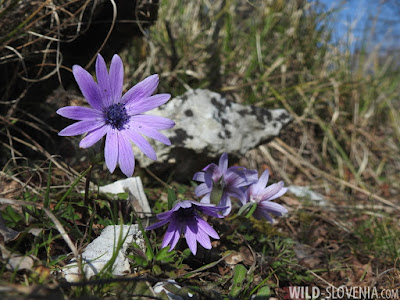After the strong spell of cold weather that hit central Europe recently, most of continental Slovenia is still under a thick layer of snow. Being heavily bored by this year's long and snowy winter, we decided to make a trip to some warmer parts of the northern Adriatic. So on Sunday we set for the Mirna river valley in Istria (NW Croatia) about 10 km from Slovenia's southwestern border. Istria is much warmer than most of Slovenia and has a more Mediterranean climate too. Even winters are mild and usually lots of birds "escape" the cold from areas farther north, to gather at such sites as the Mirna valley. Needles to say, also some of the wildlife found in Istria is typically Mediterranean and is usually rare or absent from Slovenia. Examples among breeding birds include Black-headed Bunting Emberiza melanocephala, Roller Coracias garrulus, Spanish Sparrow Passer hispaniolensis and Red-rumped Swallow Cecropis daurica.
Our trip started with a typical winter scene. In the bay at the river Mirna's estuary there was a rough sea with 3 Slavonian Grebes Podiceps auritus, 10 Black-throated Divers Gavia arctica, 15 Common Gulls Larus canus and several Black-necked Grebes Podiceps nigricollis (some in breeding plumage).
Fortunately some spring sightings followed soon...
Among the very welcome early-spring migrants were several Garganeys Anas querquedula; up to 10, swimming on the river Mirna (above) and in the lagoon at its estuary. The first migrant Garganeys appear at our wetlands in the very first days of March, while larger numbers follow later, till the end of April. Small numbers stay throughout summer to breed at quiet and undisturbed wetlands.
In the estuary's lagoon there were also several other species of wildfowl, including numerous Wigeons Anas penelope, Teals Anas crecca, some Pintails Anas acuta and about 20 Shelducks Tadorna tadorna. On the flooded fields along the river, some large flocks of Lapwings Vanellus vanellus (several hundreds) contained the first returning Ruffs Philomachus pugnax (some in breeding plumage), two Black-tailed Godwits Limosa limosa and 3 Curlews Numenius arquata.
A brief jump back into winter and we were watching this beautiful male Merlin Falco columbarius, keeping an eye on a nearby flock of Skylarks Alauda arvensis and Meadow Pipits Anthus pratensis. This small, northern falcon is a scarce winter visitor at our latitudes and is usually found in lowland areas where flocks of small birds gather. The extensive fields in the Mirna valley are an excellent place to see this species.
Among other interesting raptors we also observed a female Goshawk Accipiter gentillis, 3 Hen Harriers Circus cyaneus and a Marsh Harrier Circus aeruginosus.
On the limestone cliffs of Istarske Toplice, in the upper part of the Mirna valley, we observed another typical winter bird, a Wallcreeper Tichodroma muraria. It was too distant to take photos, so this time we can only show you its habitat. By the beginning of April most of the wintering Wallcreepers at karstic cliffs will have departed for their alpine breeding grounds.
Among the few plants in flower at this time of year were these beautiful Broad-leaved Anemone Anemone hortensis. We found them on a dry rocky grassland on a limestone hill overlooking the Mirna valley. Being a typical Mediterranean species, this anemone is widespread in Istria (and Croatia in general), but very rare in Slovenia, with only one known locality in the southwest of the country.
On the dry grasslands some other plants were making an early appearence, including Lesser Celandine Ficaria verna (Ranunculus ficaria) and the leaf-rosettes of an Ophrys species, most probably Early Spider Orchid O. sphegodes.
This small Yellow Star of Betlehem that we found on the dry grassland is probably Gagea pusilla (we are still processing the ID), a relative of the common Gagea lutea, usually found on damp soils in woodlands.
Prickly Juniper Juniperus oxycedrus is a common shrub on the termophilous hills above the Mirna valley and a typically Mediterranean plant. Note that the fruits are not purple-blue as in the Common Juniper J. communis, but rather reddish and quite larger.
The shrub layer in woodlands was adorned by the flowers of Cornelian Cherry Cornus mas, a common shrub throughout Istria and Slovenia. However those in Istria were the first flowering specimens we saw this year; in Slovenia the weather was still too cold to make them bloom.
Spring Crocus Crocus vernus in a wet woodland by the river Mirna, where plants like Lungwort Pulmonaria officinalis, Wood Spurge Euphorbia amygdaloides, Primrose Primula vulgaris and Lesser Periwinkle Vinca minor were also in bloom.
Among other birds on the fields of the Mirna valley was also this Stonechat Saxicola torquatus, a Great Grey Shrike Lanius excubitor, some Corn Buntings Emberiza calandra and a huge flock of Starlings Sturnus vulgaris (several thousands).
The first singing birds this year included: Blackcap Sylvia atricapilla, Blackbird Turdus merula, Woodlark Lullula arborea, Corn Bunting Miliaria calandra, Green Woodpecker Picus viridis and other woodland species. We also caught a glimpse of two butterflies: a Brimstone Gonepteryx rhamni and an Admiral Vanessa atalanta. Spring at last!
If you'd like to experience a vast array of widlife in Istria this spring, here is a tour we'll be co-guiding with Honeyguide Widlife Holidays. For other tours covering Istria see WildSlovenia - Tours.














